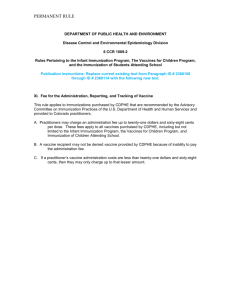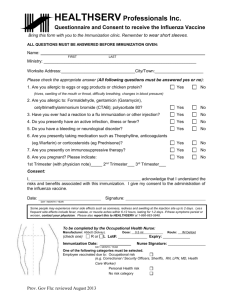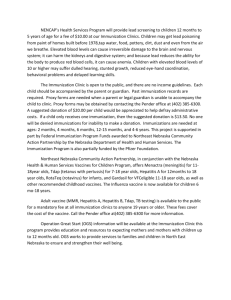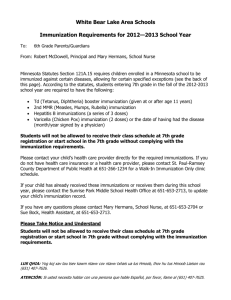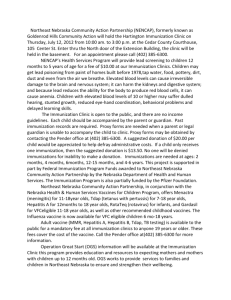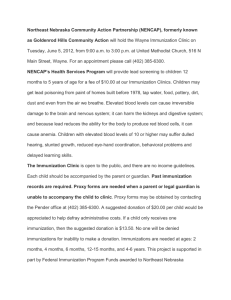- D-Scholarship@Pitt
advertisement
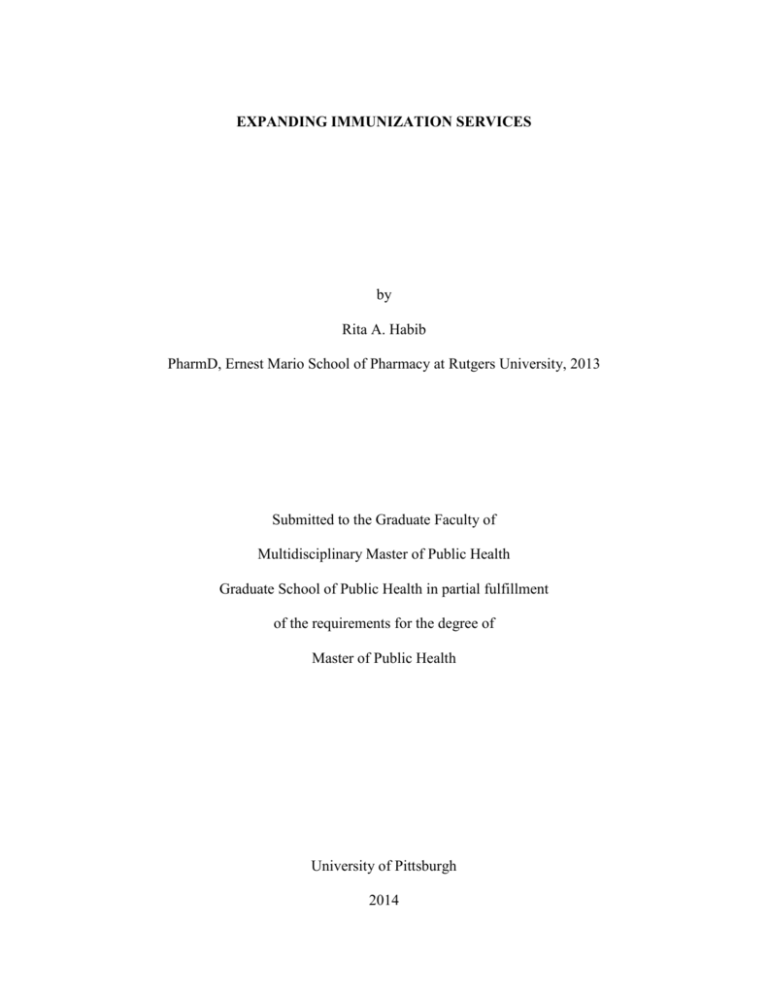
EXPANDING IMMUNIZATION SERVICES by Rita A. Habib PharmD, Ernest Mario School of Pharmacy at Rutgers University, 2013 Submitted to the Graduate Faculty of Multidisciplinary Master of Public Health Graduate School of Public Health in partial fulfillment of the requirements for the degree of Master of Public Health University of Pittsburgh 2014 UNIVERSITY OF PITTSBURGH GRADUATE SCHOOL OF PUBLIC HEALTH This essay is submitted by Rita A. Habib on December 12, 2014 and approved by Essay Advisor: David Finegold, MD Director Multidisciplinary Master of Public Health Professor, Human Genetics Graduate School of Public Health University of Pittsburgh ______________________________________ Essay Reader: Nicholas G. Castle, MHA, PhD ______________________________________ Department of Health Policy and Management Graduate School of Public Health University of Pittsburgh ii Copyright © by Rita A. Habib 2014 iii David Finegold, MD EXPANDING IMMUNIZATION SERVICES Rita A. Habib, MPH University of Pittsburgh, 2014 ABSTRACT Purpose: Each year in the US, an average of 30,000 people die from vaccine preventable diseases. Although providers may stock seasonal vaccines, there are financial disincentives to keeping regular inventory of others; therefore common vaccines for adults may not be readily available resulting in lower vaccination rates. As vaccination has reduced the burden of infectious disease, the impact of low vaccination rates has a significant impact on public health. The purpose of this pilot is for pharmacy to collaborate with key stakeholders in the hospital to plan and implement a hospital-based outpatient immunization clinic focused on raising adult vaccination rates. Methods: The immunization clinic planning and implementation team includes the hospital executive for business development, a lead physician champion, inpatient and outpatient pharmacy representation, and communication team members. The planning process included three phases and was followed by a pilot to refine the process before disseminating marketing and promotional materials. The immunization clinic was established within the outpatient pavilion on the West Penn Hospital campus. All preventative vaccines are available with the exception of travel immunizations. A short survey will be administered to patients after they are vaccinated, assessing their view on immunizations as it relates to their overall health and how they were referred to the service. iv Discussion/Conclusion: After the initial pilot, data will be collected to reflect patient volume, revenue, overall satisfaction, and vaccines administered. When patient volume increases, the next steps will be to compare the group that was immunized to a comparable control and evaluate differences in health outcomes including emergency department visits, hospitalizations, other measures of morbidity, and mortality. v TABLE OF CONTENTS 1.0 INTRODUCTION ........................................................................................................ 1 1.1 ADULT IMMUNIZATION SCHEDULE ......................................................... 3 1.2 WHY ARE VACCINATION RATES SO LOW? ............................................ 2 2.0 1.2.1 Physicians’ Outlook on Low Vaccination Rates ........................................... 3 1.2.2 Pharmacists as Alternate Vaccinators ........................................................... 3 1.2.3 Pharmacists’ Role in Raising Adult Immunization Rates ........................... 5 ESTABLISHING AN OUTPATIENT IMMUNIZATION CLNIIC IN A HOSPITAL SETTING ................................................................................................................. 6 3.0 2.1.1 Developing a Pre and Post Immunization Survey ........................................ 8 2.1.2 Pre-Immunization Survey ............................................................................... 8 2.1.3 Post-Immunization Survey ............................................................................. 9 2.2 PROMOTION AND MARKETING.................................................................. 9 2.3 IMMUNIZATION CLINIC OPERATIONS .................................................. 10 2.4 MEASURING SUCCESS ................................................................................. 12 CONCLUSION........................................................................................................... 13 BIBLIOGRAPHY ....................................................................................................................... 16 vi LIST OF FIGURES Figure 1. 2014 CDC Adult Immunization Schedule (CDC 2014) .................................................. 3 Figure 2: Planning Phases I-III ....................................................................................................... 7 Figure 3: Patient Screening Workflow ......................................................................................... 11 vii PREFACE Acknowledgements: - Mark LaRosa, MHA – Vice President of Business Planning and Development, West Penn Hospital - Jenifer Rudin, MD – Infectious Diseases, Allegheny Health Network - Matthew Eberts, PharmD, MBA, FASHP – Director of Pharmacy, West Penn Hospital - Jennifer Davis, PharmD, MBA – Director, Outpatient Pharmacy Services, Allegheny Health Network viii 1.0 INTRODUCTION As noted by physician representation from infectious diseases within the Allegheny Health Network, adult immunization rates have been consistently low from year to year (Williams 2012). Although immunization screening may be conducted by primary care physicians, this process has been shifting outside of the primary care setting (Hurley 2014). The goal of this initiative is to pilot an immunization clinic lead by a pharmacist and other healthcare providers who are certified to immunize, in order to raise adult vaccination rates. The following information describes the planning and implementation of the pilot with considerations for future research. Immunizations are recommended for adults based on different combinations of indications such as age, chronic conditions, and behavioral risk factors. Every year an average number of 30,000 individuals die in the United States from a vaccine-preventable disease (Hurley 2014). More than 95% of these persons are adults (Hurley 2014). As set forth by the Centers for Disease Control and Prevention (CDC), the Advisory Committee on Immunization Practices (ACIP) recommends twelve different vaccines for adults based on age, catch-up status, chronic conditions, and risky behaviors (CDC 2014). Overall, vaccination rates remain low and well under Healthy People 2020 goals (CDC 2014). As one of the most cost-effective measures in public health, the importance of vaccination is widely recognized for children and pediatric rates are reported at 90%, but remain low in adults (Marks 2009). This is aided with the 1 integration of vaccines in routine pediatric care (Marks 2009). The trend in racial disparities in preventive services offered and received has been documented for various immunizations (Nowalk 2008). Racial and ethnic gaps have been consistent and continue to increase for Tdap, herpes zoster, and HPV vaccinations (CDC 2014). Since immunization rates must increase to reduce the incidence of vaccine-preventable diseases, the Community Preventive Services Task Force in addition to other authorities have recommended that healthcare providers conduct a needs assessment and offer vaccines as routine clinical practice for adult patients (Williams 2012). One of the considerations for this immunization clinic was identifying methods that would increase vaccination rates in racial minorities. Due to limitations found by primary care providers, and the complexity of the CDC Immunization Schedule, it is difficult for adult patients to keep up with these preventive services (Hurley 2014). A focus on Health and Wellness throughout the Allegheny Health Network (AHN) was an optimal environment for healthcare providers to launch a vaccine focused initiative- an immunization clinic with comprehensive vaccination screening by a pharmacist or other practitioner. The immunization clinic planning and implementation team includes the hospital executive for business development, a lead physician champion, inpatient and outpatient pharmacy representation, and communication team members. After evaluating background information for recommended immunizations, the team immediately began the planning process for establishing an immunization clinic within the hospital in order to raise adult vaccination rates. The planning process consisted of three main phases which are described below. Prior to developing a business plan, the team first explored which vaccinations are recommended per the CDC adult immunization schedule, specific patient populations to consider, existing barriers to 2 raising adult immunization rates, and which healthcare providers would administer vaccines to patients in the clinic. 1.1 ADULT IMMUNIZATION SCHEDULE Figure 1. 2014 CDC Adult Immunization Schedule (CDC 2014) Based on the CDC immunization schedule, vaccines that are indicated in adults include influenza (flu), Td/Tdap (tetanus, diphtheria, pertussis), varicella (chicken pox), HPV (human papilloma virus- causes genital warts and cervical cancer), zoster (shingles), MMR (measles, mumps, 3 rubella), PCV13 and PPSV23 (pneumococcal pneumonia), meningococcal (meningitis), Hepatitis A, Hepatitis B, and Hib (haemophilus influenzae) (CDC 2014). As illustrated in Figure 1, these immunizations may be indicated or contraindicated with the presence of the following conditions: Pregnancy Immunocompromising conditions disease; receipt of dialysis (excluding human HIV infection – CD4+ Asplenia (including splenectomy immunodeficiency virus [HIV]) Kidney failure; end stage renal and elective persistent complement component Figure 1: CDC Adult Immunization Schedule deficiencies) T lymphocyte count <200 cells/µL Chronic liver disease or >200 cells/µl Diabetes Men who have sex with men Healthcare personnel (MSM) For patients with diabetes, it is critical that they are up to date with recommended immunizations including influenza, pneumococcal pneumonia, and hepatitis B vaccines (Diabetes Care 2011). These are common infectious diseases that lead to high morbidity and mortality rates in patients with chronic disease conditions such as diabetes (Diabetes Care 2011). Although patients without chronic diseases may suffer from complications due to preventable diseases, individuals with diabetes are six times more likely to be hospitalized and three times more likely to die from difficulties related to influenza or pneumonia (Diabetes Care 2011). Additionally, data presented at the CDC Advisory Committee on Immunization Practices 4 indicated that hepatitis B vaccination of adults with diabetes may prevent more than 5,000 hepatitis B infections (AADE 2012). There is also evidence that annual administration of the influenza vaccine has decreased diabetes-related hospital admissions during flu outbreaks, by as much as 79% (AADE 2012). Based on this evidence, individuals with diabetes were one of the main patient populations that the planning and implementation team proposed to target when launching the immunization clinic. After defining patient populations and reviewing the CDC adult immunization schedule, the foundation for the immunization clinic business plan was created. In order to plan the operations of the clinic, it was also important to review what barriers may exist for raising vaccination rates and which healthcare personnel would administer the vaccines. 1.2 WHY ARE VACCINATION RATES SO LOW? Coverage rates for vaccinations have been consistently low from year to year. Pneumococcal vaccine rates for adults > 65 years old were 59% overall in 2011 and 65% amongst Caucasians compared to other ethnic groups (Williams 2012). Hepatitis A vaccination coverage (>2 doses) was most recently estimated in 2012 at 12.2% (Williams 2012). Hepatitis B coverage (>3 doses) among adults aged 19-49 years old was 35.3% in 2012, similar to the year before (Williams 2012). 2 1.2.1 Physicians’ Outlook on Low Vaccination Rates When addressing why vaccine rates have been low throughout the years it is important to consider the physicians’ views on the adult vaccine delivery system. One consideration is that vaccine delivery has shifted from the traditional primary care setting (Hurley 2014). The availability of vaccines in pharmacies and use of collaborative care protocols amongst pharmacists and physicians is one component that can be noted in the change of the vaccine delivery system. A survey was developed to evaluate physicians’ views on assessment of vaccination status, stocking routinely recommended vaccines in the office inventory, and referral practices to alternate vaccinators if a vaccine was not immediately available at the practice (Hurley 2014). Although most physicians reported assessing patients’ vaccination status at an annual visit, fewer reported asking at every visit. Only 29% of general internists (GIM) and 32% of family medicine (FM) physicians evaluated a patients’ immunization status at each visit. When addressing the ease of screening for immunization status, 46% of GIMs and 48% of FMs reported the activity to be “moderately/very difficult” (Hurley 2014). Based on this information, the immunization planning committee further made the case for shifting immunization screening to alternate setting, dedicated to providing this service. 1.2.2 Pharmacists as Alternate Vaccinators When evaluating physicians’ attitudes toward other vaccinators, some may consider it unfavorable since they do not receive documentation (Hurley 2014). Most primary care 3 providers felt that it is their responsibility to see that their patients receive recommended vaccines, even if they receive them somewhere else (Hurly 2014). Only about 50% of responders indicated that it is their responsibility to stock and administer all routinely recommended vaccines (Hurley 2014). From these viewpoints, it is reasonable to conclude that although primary care providers may conduct immunization screening with the goal of keeping their patients up to date, it may not be reasonable to do so when considering all vaccinations that must be routinely stocked and the cost of maintaining the inventory. Additionally, standing order programs have been shown to be effective for increasing vaccination rates. In these programs, a non-physician medical staff member can assess a patient’s immunization status and administer vaccines without the patient’s immediate involvement (Nowalk 2012). In 2009 however, only 42% of physicians in the country indicated using this model for adult influenza immunizations (Nowalk 2012). Certain factors associated with the use of standing order protocols included the CDC/ Centers for Medicare and Medicaid Services (CMS) stance, the strength of the written collaborative agreement, how staffing can facilitate the process, and components of the electronic medical record (Zimmerman 2011). With an opportunity to involve alternate vaccinators through a standing order program, an immunization clinic managed by pharmacists in the hospital setting is optimal for managing vaccine inventory. With the use of a collaborative agreement or delegation of duties, the pharmacist or healthcare provider administering the vaccine in a clinic will also be responsible for sending documentation to the patient’s primary care physician in order to keep them updated as well. 4 1.2.3 Pharmacists’ Role in Raising Adult Immunization Rates In March 2013 it was noted by Erin Kennedy, DVM, MPH, Medical officer at the CDC National Center for Immunization and Respiratory Diseases, that pharmacists are instrumental in driving CDC programs and boosting immunization rates (APhA 2013). Pharmacists in the community setting are in a strategic position to increase vaccination in individuals with chronic conditions such as diabetes, asthma, and cardiovascular disease (APhA 2013). Utilizing pharmacists from standpoint of an immunization clinic based in the hospital is a unique approach for increasing adult vaccination rates, based on similar pharmacist-lead models. After identifying vaccines to be stocked, key barriers, and alternate vaccinators, the planning and implementation team utilized this information in the three phase development process, outlined below. 5 2.0 ESTABLISHING AN OUTPATIENT IMMUNIZATION CLNIIC IN A HOSPITAL SETTING According to the Community Preventive Services Task Force, evidence shows that reminder and recall interventions show effectiveness in improving vaccination coverage in children and adults, in different populations, and when applied at different levels such as individual practice settings and entire communities. Other documented methods proven to increase vaccination rates include provider assessment and feedback, and health care system-based interventions (Community 2014). The association also recommends expanding access in medical or public health clinical settings to reduce the distance from the patient to the clinic site, increase hours of service, deliver vaccinations in clinical settings where they may not previously have been offered, and reduce administrative barriers (Task Force on Community Preventive Services 2008). The immunization clinic planning and implementation team included the hospital executive for business development, a lead physician champion, inpatient and outpatient pharmacy representation, and communication team members. The first phase of planning included developing a business plan, identifying eligible patient populations, projecting volume and expected reimbursement, and developing the process flow. The second phase included drafting agreements with the lead physician, creating marketing materials, and evaluating technology needs. The final phase includes purchasing equipment and supplies, evaluating staff training needs, and reviewing/addressing other program and hospital requirements. 6 Figure 2: Planning Phases I-III The immunization clinic was established within the outpatient pavilion on the West Penn Hospital campus. When designing the operational component of clinic practices, consideration was given to hours that the service would be available and incorporating evening options. When assessing the implications of off-clinic hours, one study concluded that individuals who seek this service at expanded hours can be described as male, younger, and healthier, and reside in an urban area (Goad 2014). If this trend applies to this immunization clinic, adding evening hours would reach a different patient population and help achieve the ultimate goal of increasing vaccination rates. All preventative vaccines were included with the exception of travel 7 immunizations. Provider and pharmacy staff will conduct individualized vaccination history reviews with the patients and develop an immunization plan. 2.1.1 Developing a Pre and Post Immunization Survey A short survey will be administered to patients before and after they are vaccinated, assessing their view on immunizations as it relates to their overall health and how they were informed about the service. In the pre-immunization survey, the first question outlines how the patient may have been referred to the service, whether it was through their physician, a required health and wellness visit, hospital discharge, promotional materials, etc. Once aggregated, the result of this question will allow the planning and implementation team to further focus efforts considering how the service is best promoted. The second question assesses why the immunization screening is important to the patient and which component of wellness they value the most. The postimmunization questionnaire addresses satisfaction by inquiring whether the patient would or would not recommend the service to family and friends. Finally, the last question investigates other components of health and wellness may be valued by the patients including more frequent doctor visits, updating medications, or lifestyle modification changes. The survey was reviewed by the hospital’s institutional review board (IRB) which categorized it as exempt with the classification of quality improvement. 2.1.2 Pre-Immunization Survey 1) How did you find out about immunization clinic? a. Health & Wellness Visit b. Physician c. Health insurer 8 d. Friend e. Hospital discharge f. Brochure 2) What do you expect from this immunization? a. To improve overall health with fewer doctor visits b. Less admissions to the hospital c. To prevent transmission of disease to other family members 2.1.3 Post-Immunization Survey 1) Would you recommend the clinic to family/friends for immunizations? a. Yes b. No 2) Are there other things you should be doing to improve your health? a. Seeing my doctor more b. Updating medications c. Lifestyle modification changes such as healthy eating and exercise d. Other_________________ 2.2 PROMOTION AND MARKETING The immunization clinic planning and implementation team worked with representation from marketing and communications in the hospital to develop promotional materials to ensure that individuals in the community are aware of the service. A brochure was developed which included background information on current vaccination rates in the country, why adults need 9 vaccines, which individuals may be at risk, available vaccines, safety information, and contact information for scheduling an appointment. Overall, the information found in the promotional material was written in layman’s terms and contained images that were culturally appropriate. The “Who is at risk?” component includes information to highlight the relevance of vaccines for patients with chronic diseases such as diabetes, and those who are 60 years or older. After finalization of the brochure, the team will evaluate where they can be distributed. Part of this process includes familiarizing primary care physicians in the area, with the service so that they may refer their patients to an alternate vaccinator if they do not have the inventory to provide them with recommended immunizations. Since promotion is a key component of launching a new healthcare service, additional measures may be considered to supplement the brochure. To raise awareness during August which is National immunization Awareness Month (NIAM), the National Public Health Information Coalition (NPHIC) in conjunction with the CDC, provided a toolkit which aids communication on vaccine necessity. The toolkit includes newsletters, presence on social media, and visuals for different websites (NAIIS Patient Education Work Group 2014). These strategies are also to be considered when educating individuals in the community about the importance of vaccinations and this specific service. 2.3 IMMUNIZATION CLINIC OPERATIONS A major component of the planning process was mapping out the flow of the immunization clinic and how screening and vaccine administration would operate. In addition to the pharmacist, there is support staff at the health and wellness center that can assist with the process 10 of scheduling, recording demographics, primary care physician information, insurance information and immunization history. The pharmacist or other healthcare provider would then review immunization eligibility in accordance with CDC recommendations, administer vaccinations, and follow up with documentation. Figure 3 depicts an initial draft of the Immunization Screening Workflow. As the pilot launched, adjustments were made to the workflow to depict the true operations of the immunization clinic. The pharmacist was more proactive in retrieving the initial immunization history. Subsequently, the pharmacist was in close contact with the lead physician, following up with any questions and concerns. For several vaccinations, an additional one or two visit was needed and follow up was common to complete the course of the vaccine. Figure 3: Patient Screening Workflow 11 2.4 MEASURING SUCCESS In the first 21 days of the immunization clinic pilot, patients who were assessed at the immunization clinic received various vaccinations including influenza, zoster, pneumococcal, hepatitis A and hepatitis B. After patient volume increases, data will be collected to evaluate satisfaction, vaccines administered, as well as revenue. Results from the pre and post immunization survey will allow the team to assess how patients were referred to clinic and what motivated them to take action concerning their own vaccination needs. Although revenue from reimbursement is not a primary driver of providing this preventative service, it may allow the team to justify the case for expanding the service in the future. Success will also be measured by evaluating the impact on health outcomes in patients who receive the immunization screening. If compared to a similar control group, the team can measure the impact that vaccines had on health and wellness. For companies that implement adult immunization programs for their employees, some of the metrics evaluated include worker productivity, health care costs, and health outcomes. The latter includes determining levels of diagnostic and treatment procedures that are related to vaccine-preventable diseases such as influenza (CDC 2013). Although these measures are specifically designed for workers who participate in these employee health programs, they can be extrapolated to this initiative. The ultimate measure of success will be to show the decrease in morbidity and mortality related to vaccine-preventable diseases. 12 3.0 CONCLUSION As patient volume increases and the initiative is fully launched after promotional materials are disseminated, there are several limitations to consider including technology requirements, measuring health outcomes, and caveats regarding survey results. Another component of the immunization clinic that will be considered in future plans is aligning vaccination in the transition of care process. Currently, the pharmacist or healthcare provider conducting the immunization screening is collecting patient information in a Microsoft Excel® spreadsheet where demographics, indicated vaccine, and administered vaccine data is collected. One of the initial limitations in this process is adding information for patients who are coming to the clinic for the second or third visit as part of an individual vaccination schedule. Additionally, since this database is not linked to the hospital’s electronic health record (EHR), additional documentation has to be maintained in the EHR and further distributed to the patient’s physician. Further, to report on health outcomes including emergency department visits or hospitalizations, the team would have to request reports from other hospital personnel or even work with the patients’ health plans to assess the impact on healthcare expenditures. Moving forward, there may be an opportunity to integrate immunization information systems. These confidential, population-based, computerized databases are designed to record all vaccination doses administered by the participating provider and have been shown to raise immunization rates and reduce the risk of vaccine-preventable 13 disease (Groom 2014). Based on a systematic review, utilization of immunization information systems has been most widely used in children (Groom 2014). When Walgreens expanded services offered in their community pharmacies to include administering vaccinations, one initiative was to leverage technology through a clinical data exchange between the pharmacies and state public health departments (National Adult Immunization Summit 2013). At this point, the clinical expertise of the pharmacist or healthcare provider conducting the screening is utilized for all decision-making and creating the immunization plan. In the future, clinical assistance tools may be considered including the Comprehensive Clinic Assessment Software Application (CoCASA) (CDC 2013). This software is meant as a tool for evaluating immunization coverage and includes data entry as well as data import functions. Algorithms are included to help guide the healthcare provider in creating a plan for the patient (CDC 2013). Although the survey has been identified as quality improvement by the hospital’s IRB, the questions were not validated on an initial group of patients. To address this constraint, the results from the pilot phase may go through a validation and revision process before being distributed further. The next step for patient referrals is aligning the immunization clinic goals with the transition of care process as patients are discharged from the hospital and continue their care as an outpatient. When patients are discharged, they may or may not receive all recommended vaccines during their inpatient stay. While it may be common for patients to receive influenza or pneumococcal vaccines, others such as HPV or zoster may not be routinely administered. In regards to the influenza vaccine, the standard dose trivalent may be the only type that is stocked at the hospital while some physicians would recommend the high-dose trivalent influenza 14 vaccine based on recent evidence indicating higher antibody responses in persons 65 years of age or older (DiazGranados 2014). Integrating the immunization clinic information including phone number and hours into the discharge paperwork would give the patient an opportunity to follow up with vaccinations after they leave the hospital. The intent of the immunization clinic initiative is to increase adult immunization rates with an ultimate objective of reducing morbidity and mortality from vaccine-preventable diseases. In order to accurately assess these outcomes, the next steps involve further vetting data collection and analysis measures. 15 BIBLIOGRAPHY American Association of Diabetes Educators (AADE). (2012). Vaccination Practices for Hepatitis B, Influenza and Pneumococcal Disease for People with Diabetes. Retrieved from http://www.diabeteseducator.org/export/sites/aade/_resources/pdf/research/Vaccinat on_Position_Statement_2012.pdf American Pharmacists Association. (2013). Pharmacists are key players in boosting immunization rates. Retrieved from http://www.pharmacist.com/pharmacists-are-keyplayers-boosting-immunization-rates Centers for Disease Control and Prevention (CDC). (2013). Adult Immunization. Retrieved from http://www.cdc.gov/workplacehealthpromotion/evaluation/topics/immunization.html. Centers for Disease Control and Prevention (CDC). (2014). Adult Immunization Schedules. Retrieved from http://www.cdc.gov/vaccines/schedules/hcp/adult.html. Centers for Disease Control and Prevention (CDC). (2014). Vaccines that might be indicated for adults based on medical and other indications. Retrieved from http://www.cdc.gov/vaccines/schedules/hcp/imz/adult-conditions.html. Centers for Disease Control and Prevention (CDC). (2013). CoCASA (Comprehensive Clinic Assessment Software Application). Retrieved from http://www.cdc.gov/vaccines/programs/cocasa/index.htm. Community Preventive Services Task Force. The community guide; 2014. Diabetes Care. (2011). Standards of medical care in diabetes. 34 Suppl 1:S11-61. DiazGranados C.A., e.a. (2014). Efficacy of High-Dose versus Standard-Dose Influenza Vaccine in Older Adults. N Engl J Med. 371(7), 635-645. Goad J.A., e.a. (2013). Vaccinations Administered During Off-Clinic Hours at a National Community Pharmacy: Implications for Increasing Patient Access and Convenience. Annals of Family Medicine. 22(5), 429-436. 16 Groom H., e.a. (2014). Immunization Information Systems to Increase Vaccination Rates: A Community Guide systematic Review. J Public Health Management Practice. 00(00), 1-22. Hurley L.P., e.a. (2014). U.S. Physicians’ Perspective of Adult Vaccine Delivery. Annals of Internal Medicine. 160(3), 161-171. Marks S. (2009). Adult Immunization: The Need for Enhanced Utilization. The American Council in Science and Health. Retrieved from http://acsh.org/2009/11/adult-vaccinesraising-awareness-improving-access/. NAIIS Patient Education Work Group. (2014). NIAM Adult Vaccine Messaging. Retrieved from http://www.izsummitpartners.org/wp-content/uploads/2014/08/NIAM-ReachingProviders.pdf. National Adult Immunization Summit. (2013). Adult Vaccination: What Works. Retrieved from http://www.izsummitpartners.org/wpcontent/uploads/2013/whatworks/walgreens_adult_r esults.pdf. Nowalk M.P., e.a. (2008). Raising Adult Vaccination Rates over 4 Years Among Racially Diverse Patients at Inner-City Health Centers. The American Geriatrics Society. 56(7), 1177-1182. Nowalk M.P., e.a. (2012). Evaluation of a toolkit to introduce standing orders for influenza and pneumococcal vaccination in adults: A multimodal pilot project. Vaccine. 30, 5978-5982. Taskforce on Community Preventive Services. (2008). Recommendations regarding interventions to improve vaccination coverage in children, adolescents, and adults. Am J Prev Med. 18, 92-96. Williams W.W., e.a. (2012). Noninfluenza Vaccination Coverage Among Adults – United States. Morbidity and Mortality Weekly Report. 63(5), 95-102. Zimmerman R.K., e.a. (2011). Use of Standing Orders for Adult Influenza Vaccination: A National Survey of Primary Care Physicians. Am J Prev Med. 40(2), 144-148. 17

